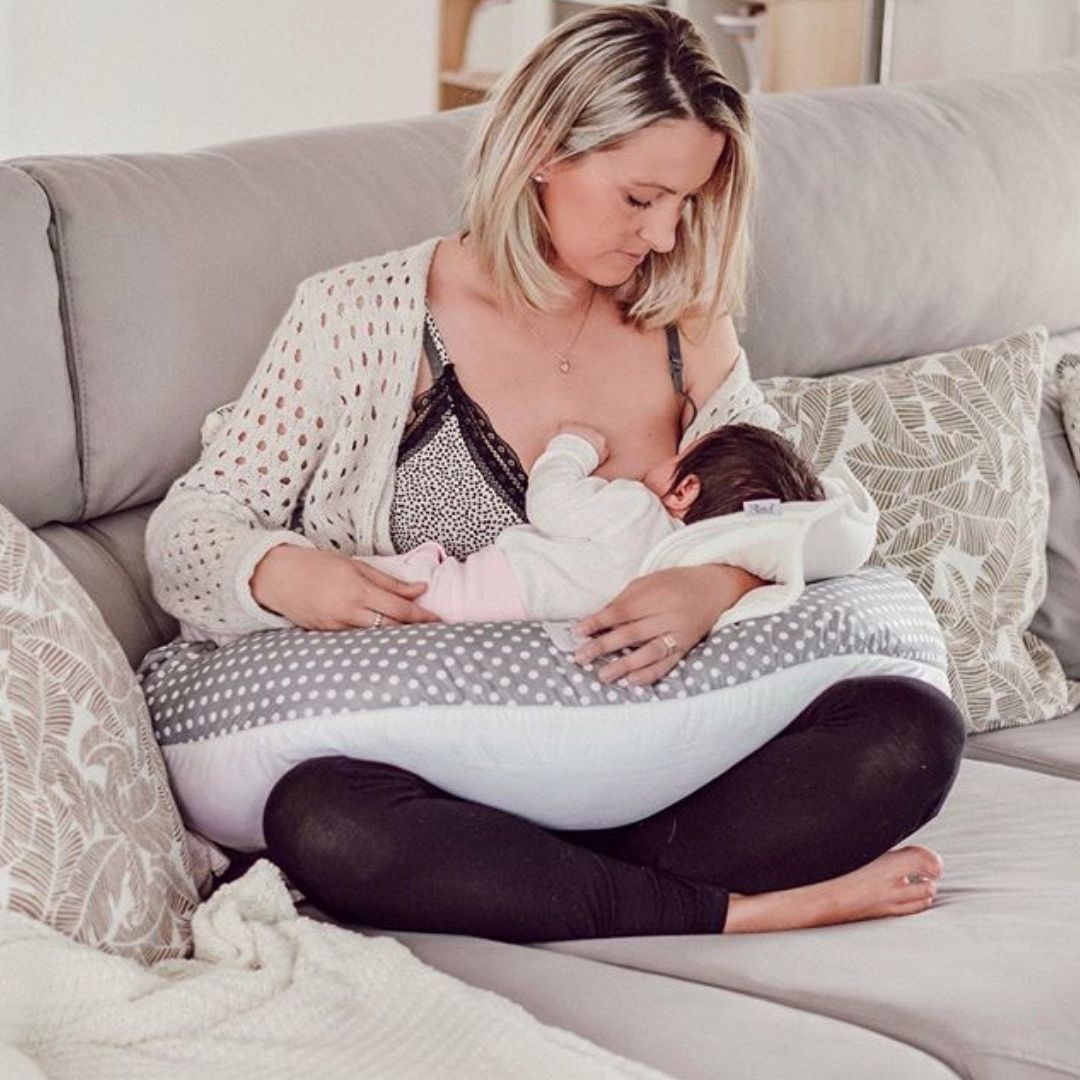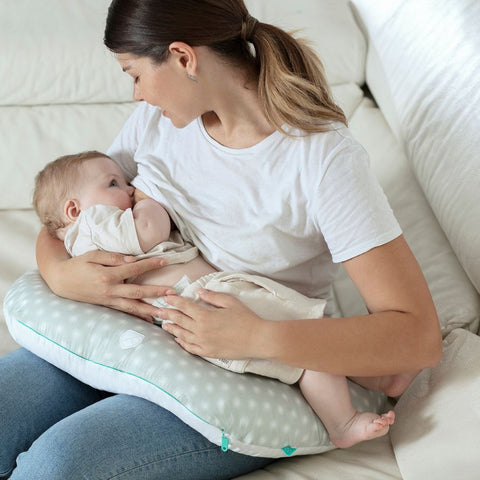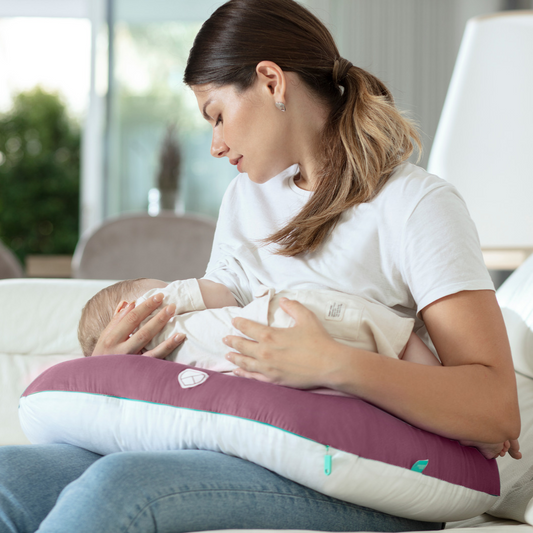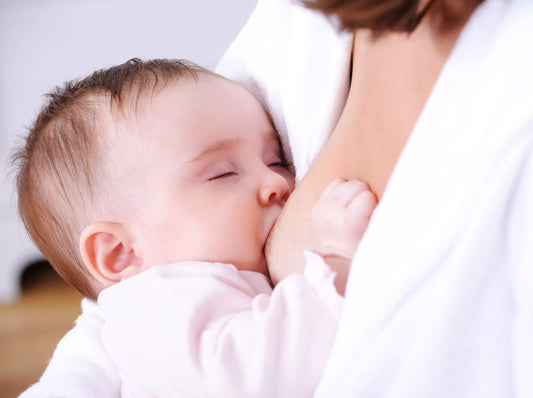Out of all the positions for breastfeeding, is there one universally recognised as the best?
Quite simply, no. Every mum has her favourite, the one she finds the most comfortable. That’s why it's a good idea to try out various positions before finding the best one for you and your baby.
No matter what position you choose, you need to make sure that both you and your baby are comfortable.
Keep anything you may need close at hand, such as a bottle of water, a magazine, a book, the TV remote control, etc.
Here are some tips from the NHS to help your baby get a good latch:
- The baby's face should be facing your breast with his head, shoulders and body aligned.
- The baby's nose or upper lip must be level with the nipple.
- The baby must be able to easily reach the breast without needing to stretch or turn over.
- Always bring the little one close to your breast, and not the other way around.
Is there a right way to breastfeed?
There isn't one position that's better than another when it comes to breastfeeding: everyone must find the right position for them, the main thing is that it's comfortable for both mum and baby.
Trying out various breastfeeding positions is a good idea so that you can find the best one for you and your baby, and so that you're more versatile when you have changes in your usual routine. For example, when you're not at home, or if you have problems like mastitis or infant reflux.
9 comfortable positions for breastfeeding
Here you'll find a list of all the most comfortable breastfeeding positions for breastfeeding your baby, from the most traditional to the more unusual.
The latter are especially useful in specific situations, such as infant reflux or when the breast is particularly large.
1. Laid-back breastfeeding

The first position that most mothers experience is the reclined or semi-reclined position, in the hospital bed.
The mother is lying down, and the baby is placed on her chest or stomach.
The baby instinctively moves towards the breast and tries to latch. This is an innate reflex, stimulated by skin-to-skin contact with the mother and by the force of gravity, which helps the baby latch and remain still.
This position is comfortable when:
- The baby struggles to latch in other positions.
- The baby does not like to have his head touched during feeding.
- The mum's breasts are very big.
- If there is a forceful let-down.
2. Semi-reclined position

The semi-reclined position is perhaps a more comfortable version of the reclined position. This is because pillows or a back support are used to raise your upper body a little.
In this way, you can see your baby.
3. Rugby hold position

This breastfeeding position is so-called because the baby is held on his side and is supported by one arm only, just like how a rugby ball is carried.
This position has several advantages: the grip is firm, the baby feels safe, and the mother can see his face.
When this position is comfortable:
- For mums who have had a caesarean.
- For mums with particularly large breasts.
- For twins because it allows both to be breastfed at the same time.
4. Dangle position

In this breastfeeding position, the baby lies on his back, while the mother crouches on all fours above the baby and dangles the nipple at the baby's mouth.
This isn't the most comfortable position, especially when not at home. But it can be a good alternative in some situations:
- It helps in case of mastitis, when it’s best to prevent the breast from being squashed or touched.
- Although it's not scientifically proven, many mums use this position when they have blocked milk ducts because they feel that gravity helps unblock them.
5. Upright or Koala Breastfeeding Position

In the upright or koala breastfeeding position, the baby straddles the mum's thigh or hip, so that his back and head are upright.
This position is easier with bigger babies who can already sit up on their own, while a new-born obviously needs a lot of support from the mother.
When this position is comfortable:
- For babies with infant reflux, when it's best for them to be upright.
- If the baby is suffering an ear infection and lying down is usually painful.
- It may also be useful with babies suffering from tongue tie (ankyloglossia) or reduced muscle tone.
6. The Cradle Position
This is the classic position, the first one that comes to mind when we talk about breastfeeding.
The mum sits with the baby in her arms in a horizontal position, with the baby's head and neck supported in her forearm.
It’s a good idea to use a breastfeeding cushion, such as Koala Hug Baby, to help you support the weight of the baby by reducing the strain on your arms, shoulders and back.
Also, in this way the baby's head is supported by a softer support than the mother's arm. A key factor in preventing positional plagiocephaly.
7. Cross-cradle hold

This is a variation of the cradle position: the arm that supports the baby is on the opposite side to the nursing breast. In this way, the mum can better support the baby.
It is particularly suitable for very small or premature babies.
8. Side-lying position

In this position, the baby and the mother are lying on one side next to one another, belly to belly.
It is a comfortable breastfeeding position for night-time feeding or on the sofa.
It is ideal after a caesarean section or if you have stitches.
9. Breastfeeding in a sling

Although not specifically created for breastfeeding, the sling can be used comfortably when you're out and about.
The main thing is to keep the baby's face visible so that you know he's in the right position.
Have you tried any of these positions? Which works best for you?
For any doubts regarding the correct position of the breastfeeding baby or in the event of complications such as nipple fissures and mastitis we recommend you contact your obstetrician.









